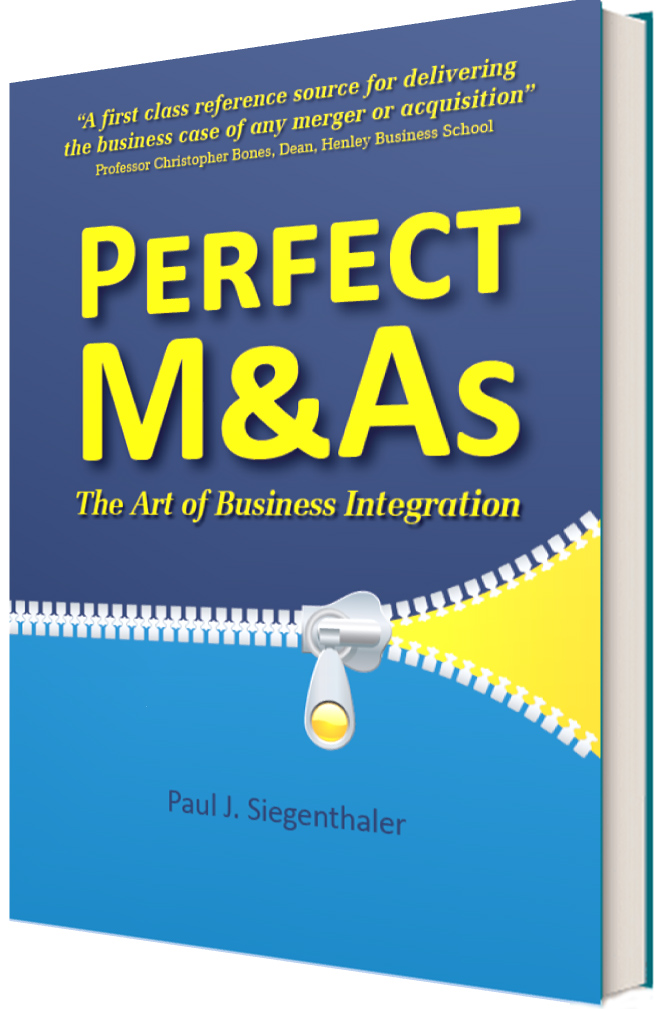Paul J. Siegenthaler has helped numerous merging or acquired companies to integrate successfully, and has driven major business transformation programmes across Western Europe, North America and worldwide, ensuring they deliver the business case shareholders had been promised.

Realising the value of your merger or acquisition
50% to 80% of mergers and acquisitions fail.
How can one succeed?
Business integration is an art : the combination of talent and technique. It takes strong leadership and a solid approach to change management.
What structure, resources, behaviour and interaction are key in shaping people’s minds, building acceptance of change, energizing teams, creating a sense of common purpose, blending two organisations into one and actually delivering the merger’s business case ?
Perfect M&As – The Art of Business Integration
“This book is a first class reference source for delivering the business case of any merger or acquisition. Paul Siegenthaler’s experience as a practising manager in the field of international M&A is unrivalled. His insights and advice are invaluable. It thoroughly recommend this book to anyone thinking about M&A as a route to growing business or improving public service efficiencies”
Prof. Christopher Bones
Dean, Henley Business School
University of Reading
Successfully integrating companies is a transferable skill
Companies that carry out regular acquisitions and make this one of their core competencies tend to perform better than their peers. This is good news, because it means that not all is random when it comes to the art of integrating companies: there are some lessons that can be learnt and applied. This is what sets the 20% of really successful post-acquisition integrations apart from the majority that end in failure.
Shareholders asked to approve a merger or acquisition assume it will be a success, when in fact they should assume that the outcome will be a failure unless experienced resource in brought in to provide advice, structure, direction and support.
Boosting shareholder returns is the economic justification of mergers and acquisitions; however, unless the resulting merged business significantly outperforms the returns that were achieved by its constituent companies in recent years, identifying the merger or acquisition as the key driver of that improvement can be a hazardous exercise, because many other factors come into play.
Nonetheless, determining whether the integration process was a success or failure is far more straightforward, as it can be measured against the promises that were made to the shareholders who approved the deal. Ultimately, the three following questions will be asked :
- Were the projected cost synergies achieved?
- Did the integration costs remain within the allotted budget?
- Was the integration completed on time?
On the basis of the above simple criteria, more than half of M&A integrations fail to reach their objective, in most cases because the integration costs end up being much higher than anticipated, to the extent that these cannot be offset by any additional synergies.
Conversely, good planning, clear governance, rigorous programme management, fast issue resolution, adequate resourcing, energetic leadership, well-crafted communication, and effective stakeholder management will result in a successful outcome. But getting this right requires a good deal of experience.
This why the companies that have grown through a series of acquisitions can repeatedly integrate them successfully: they know from the onset the magnitude and complexity of the challenges they will be facing, and can prepare accordingly.
M&A can be an accelerator of growth, but it can also lead to the demise of a business if badly executed. Therefore getting things right the first time is crucially important.
Integrating two companies is an exciting venture; it is also a highly complex exercise as it potentially impacts every aspect of a business. Managing one’s company whilst getting to grips with a newly acquired business is quite a task in itself. Individuals who attempt to organise and lead the integration of those two companies in addition to running their day-to-day commercial activity are at risk of losing focus, and this is likely to adversely impact business performance. If this is allowed to happen, putting the business back on track will be the top priority, to the detriment of the integration effort.
Losing the integration’s momentum will cause it to drag on, increase its cost and most probably end in failure as personal energies wear out.
Success in M&A requires the ability to manage the dual focus on integration and day-to-day business.
Former CEO of Kraft General Foods International Jack Keenan, who had extensive experience of mergers and acquisitions, once said: “integrating companies is like pulling out teeth: you can do it quick and painful, or slow and painful; we’ll do it quick and painful”.
As unpleasant as Keenan’s words may have sounded, his statement highlighted one of the key elements underlying a successful integration: speed. Maintaining the momentum of the integration process minimizes the period of insecurity caused by the prospect of change, provides a sense of clarity and direction and prevents fatigue and strain from undermining commercial performance.
Pace does not mean race. Indeed, not thinking things through and rushing the integration could lead to a catastrophic outcome. But the prerequisite to allow the integration process to kick off at an engaging pace is extensive preparation.
Most companies ignore how much preparation can take place ahead of closing their acquisition deal. By law, there is a strict ban on the sharing of any commercially sensitive information until the deal has closed and the two businesses are under common ownership; the penalties for transgressing that ban are staggering. Many management teams, particularly those new to M&A, are unclear as to what constitutes commercially sensitive information and understandably err on the side of caution by forbidding any contact between individuals of the two companies until the deal has officially closed. In so doing, they forego the opportunity of laying the ground for the integration and accelerating that process by several months.
The first 100 days lay the basis for trust or concern: the staff needs to see and feel that things are happening, and shareholders will expect to see a few “quick wins”. However I have observed that the initial focus on the first 100 days can be detrimental to the quality of the planning and knowledge transfer that need to take place subsequently.
Typically, companies are given by their advisors a detailed plan and list of tasks that cover the first 100 days, creating a perception that most of the integration work and issues can be dealt with in that short time span. At the end of the 100 days, the majority of the consultants and advisors who supported the company in the run-up to closing the deal and in the early days of the integration process leave the scene; the management team is then left with its own resources and often a serious gap in experience to successfully complete the integration.
No one should underestimate the importance of giving the integration the right impulse from the onset: the first 100 days are the unique opportunity to build interest, energy and excitement in the company, yet during that same time everything needs to be set up to provide traction beyond the initial kick-start. For this to happen, one experienced senior resource within the company’s leadership or working alongside the executive team must be fully dedicated to delivering the integration.
Whilst the failure rate of M&A has remained stubbornly high for a number of decades, companies that pursue a systematic strategy of external growth and become “serial acquirers” repeatedly succeed in integrating the businesses they acquire. This proves that these companies are doing something which failing first-timers seem to overlook; success or failure in M&A are not the result of random luck, there are indeed learnings to be applied.
Invariably, management teams embarking on a significant acquisition without repeated prior experience seriously underestimate the amount of resource and effort that will be needed to achieve a successful integration.
Serial acquirers know what to look for during due diligence; they have a good feel for the type and magnitude of cost synergies that can be achieved; they have a realistic view of the amount of resource they will need to complete the integration; they establish clear governance and effective issue resolution processes; they prepare the ground for the integration well before the deal has closed; they understand the importance of clear leadership and communication. And finally, they manage the dual-focus of integration and day-to-day business, ring-fencing the latter to prevent the integration activity from causing any damaging disruption.
Strong leadership at the helm of the organisation and clear segregation of duties between the integration effort and daily business are the two key success factors in the companies I have integrated.
The simple answer is no, quite to the contrary! Very large companies and serial acquirers have their own in-house teams in charge of integration, with repeated successful experience of absorbing new businesses; most have developed their own approach with a proven track record.
Whereas many senior executives of mid-size companies hold the view that integrating an acquisition into their existing business should be far simpler than it is for global giant companies, the challenge is in most cases greater. These are businesses that might have 500 to 10,000 employees scattered across several locations, possibly across geographical and language barriers, operating in countries that have different legislations and business cultures. Mid-size companies do not have access to the vast resources and talent enjoyed by industry giants, their management will typically have less collective experience, and yet they will have to manage the same breadth of issues and complexity to integrate their acquisition. Same task, but with fewer means to tackle it.
The common point between very large and mid-size companies preparing for an acquisition is the extensive support they seek and receive until the close of the deal: auditors, lawyers, tax and pension experts, investment bankers and other financial institutions, functional consultants. Indeed, no effort or precaution should be spared to ensure the deal is legally sound, that the price is the right one and that the business case rests on plausible hypotheses.
Things change as soon as the ink has dried on the legal documents. Support for the integration is in most cases limited to setting up a PMO (Programme Management Office), providing a plan for the first 100 days and lists of tasks. This is the “launch pad” of the integration process, but who will pilot that rocket and maintain it in orbit after the initial launch?
The conventional wisdom is that the consultants who set up the PMO will hand-over to the business after those first 100 days. In reality, this can only work in businesses that have their own in-house integration team; for the others, in the absence of a dedicated integration leader and staff seconded to the integration programme, momentum will rapidly decline, nobody will be accountable for resolving issues and managing disks, delays in progressing the integration will cause costs to escalate, and that constant disruption will adversely impact commercial performance. In short: a failed M&A.
Post-M&A integration is not a quick fix. Companies intending to make a significant acquisition should plan on having dedicated experienced resource focused on delivering the integration for a duration of 6 to 18 months depending on the scope (the integration can progress faster in service companies compared to businesses that produce physical goods, where stocks, replenishment, spare parts, procurement, manufacturing footprint, warehousing, and logistical consideration will come into play).
